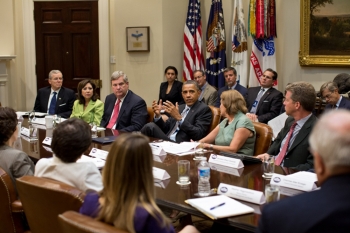Secretary Pritzker Attends World Economic Forum to Highlight Priorities Integral to Lasting Economic Recovery
This week, Secretary Pritzker traveled to Davos, Switzerland to attend the World Economic Forum and participate in a panel discussion titled “The Outlook for the United States,” which focused on what Washington can accomplish in the next two years.
Moderated by Politico editor Susan Glasser, the panel also included Governor Hickenlooper of Colorado; Andrew Liveris, President and CEO of the Dow Chemical Company; Patrick McHenry, Republican Congressman from North Carolina; and Cecilia Rouse, dean of the Woodrow Wilson School of Public and International Affairs.
During the candid conversation, Secretary Pritzker highlighted the momentum in the U.S. economy heading in to 2015, America’s strong position as a global investment destination, and the work that still needs to be done to continue a sustainable, lasting recovery. All participants agreed that trade is the most actionable agenda item that President Obama laid out in his State of the Union address. Secretary Pritzker stressed that while the American economy is already in a good position, it is imperative Trade Promotion Authority (TPA) be passed by Congress to pave the way for trade deals like the Trans Pacific Partnership (TPP) and to establish a more level playing field for American businesses globally. Completing and implementing new trade agreements will give the United States the opportunity to shape the rules that govern trade in the 21st century, while ensuring our businesses can compete around the world.
Secretary Pritzker also discussed the importance of preparing America’s workforce with the skills needed for the jobs of the future. The need for improved workforce development is an issue that has been raised by nearly all of the 1,500+ CEOs and business leaders she has met with as Commerce Secretary, and the Administration is strongly committed to working directly with the private sector to develop effective training programs that will prepare workers with the skills employers seek. Successful public-private partnerships include the Trade Adjustment Assistance Community College and Career Training (TAACCCT) competitive grant program – it has invested nearly $2 billion in hundreds of community colleges all across the country that have partnered with companies and national industry associations to expand job-driven training programs.
Deputy Secretary Bruce Andrews and Under Secretary for Oceans and Atmosphere and National Oceanic and Atmospheric Administration Administrator Dr. Kathryn Sullivan also attended the World Economic Forum. Deputy Secretary Andrews utilized the opportunity to discuss the Department’s “Open for Business Agenda” with business leaders and CEOs from around the world, while Dr. Sullivan presented on how data is a public good that can save lives.














































































